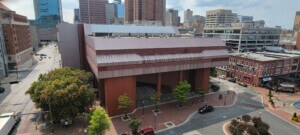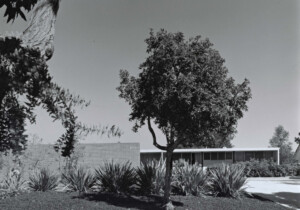Many years ago, long before I became an architecture critic, I was a 14-year-old stuck in the back of a Buick crossover whose driver, my mother, had taken a wrong turn while looking for the Goshen, New York, Dunkin Donuts. We ended up in the parking lot of the most extraordinary building I had ever seen—Paul Rudolph’s Orange County Government Center, more commonly known as the Goshen Building.
In 2009, the Goshen Building was in rather dire straits in ways immediately apparent (the concrete exterior bore the sad traces of rain and snow, the parking lot sprouted grass) and not (the roof leaked inside). Despite the outward signs of disrepair, the breath seized in my chest and as my eyes drifted over the compression and expansion of the building’s extruded masses, I realized that I had stumbled upon something extraordinary. I asked my mother, who grew up in Goshen and was visiting relatives there, if she knew what the building was. She rolled her eyes and said, “Ugh, that’s the DMV.”
When we returned home to North Carolina from our family reunion, I took to the computer and searched for the Goshen, New York Department of Motor Vehicles. Some clicking got me through to the Wikipedia page for Paul Rudolph, a mid-century architect who was once the Dean of the Yale School of Architecture. It was at that point I fell in love and became obsessed—not only with Rudolph’s work, but with architecture as a whole. My life is marked by a threshold of before and after Paul Rudolph.
I spent a good deal of my bizarre and lonely adolescence sitting in my bedroom, listening to Steve Reich and browsing SkyscraperCity threads and Flickr archives devoted to Brutalist architecture. Wanting to become a classical musician and composer, I wrote entire pieces for strings commemorating individual buildings. I drew doodles of extruded cubes in the margins of my notes.
In 2010, I had stumbled on a news article about the pending demolition of the Goshen Building. I was devastated.
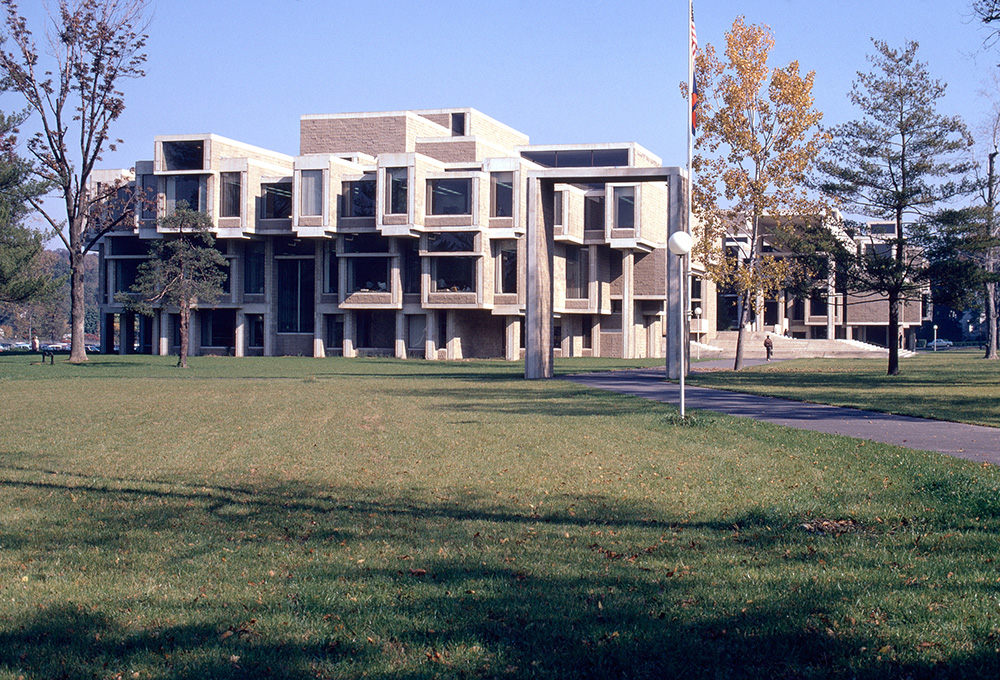
I got into many arguments with my mother, who at the time shared the majority opinion of Goshenites and thought the building an unlovable eyesore. I decided to do everything that I, a high-school sophomore hundreds of miles away, could to save it. I wrote letters to Goshen politicians, my first-ever writings on architecture; I donated my babysitting money to Docomomo, and I got involved with local North Carolina efforts to save modernist architecture through the preservation nonprofit Triangle Modernist Houses (now US Modernist). The fight dragged on for years, and by the time it was over, I was a freshman in college. I was beginning graduate school when Orange County finished lobotomizing Rudolph’s building with a horrific contemporary addition. Reflecting on the loss years later, I can’t help but be upset.
With the exception of Minoru Yamasaki, who designed both Pruitt-Igoe and the original World Trade Center, Paul Rudolph is perhaps the unluckiest architect in the history of American modernism. His career was by all accounts successful. Born in rural Kentucky to a housewife and an itinerant preacher, Rudolph studied architecture at Auburn University before earning himself a spot in the coveted graduate design program at Harvard, where he studied under such luminaries as Walter Gropius. After school, Rudolph shipped out to Sarasota, Florida, to work with architect Ralph Twitchell on small residences and public buildings. Even at this early stage of his career, Rudolph made waves. He and Twitchell, along with a few contemporaries, were responsible for establishing an entirely new idiom deemed the Sarasota School of Architecture, exemplified through the clean lines and open-air plan of his Riverview High School (demolished in 2009).
Rudolph opened his own practice in 1952 with modest success, and by the late ’50s, he had begun receiving higher-profile commissions. In 1958, he was appointed chair of the architecture department at Yale, his students including Richard Rogers and Norman Foster. Rudolph designed numerous houses around the country and a great many important projects including the Yale Art & Architecture Building, the Boston Government Service Center, and numerous buildings for the University of Massachusetts at Dartmouth. However, Rudolph lived long enough to see the tide turn against modern architecture, and his reputation tarnished as a result. The wrecking ball soon tore through Rudolph’s portfolio. Riverview, Buffalo’s Shoreline Apartments, houses in Connecticut, Rhode Island, and Florida, and the Christian Science Organization Building rank among the fallen, while the Boston Government Service Center is under grave threat. The latest victim in this saga of devastation is his Burroughs Wellcome Co. Headquarters and Research Building in Durham, North Carolina.
Opened in 1972, Burroughs Wellcome is one of Rudolph’s most famous projects, popularized by its role in the 1983 sci-fi film Brainstorm. The elevation drawings of the main building have served a lesser role as my computer’s desktop background for ten years. Imagine my delight as a teenager, having discovered this fantastic architect whose buildings defy comprehension, and learning that he built a major project an hour from my house. At that point, around 2010, the Burroughs Wellcome campus had been purchased by United Therapeutics, with tentative plans to turn the lobby and administrative building into a visitors center and demolishing the rest. The visitors center came to naught and the property was cordoned off and left to fester. I begged my father, who was going to Durham to go look at an old radio he saw on Craigslist, to take me with him so we could pay the building a visit. I still remember pulling to the side of the road, craning my head to get a glimpse of those emergent, geometric concrete forms looming over the landscape on delicate pillars, perfectly still and yet in motion. I asked my dad if we could get a closer look, but he said that would be trespassing. I should have pressed him.
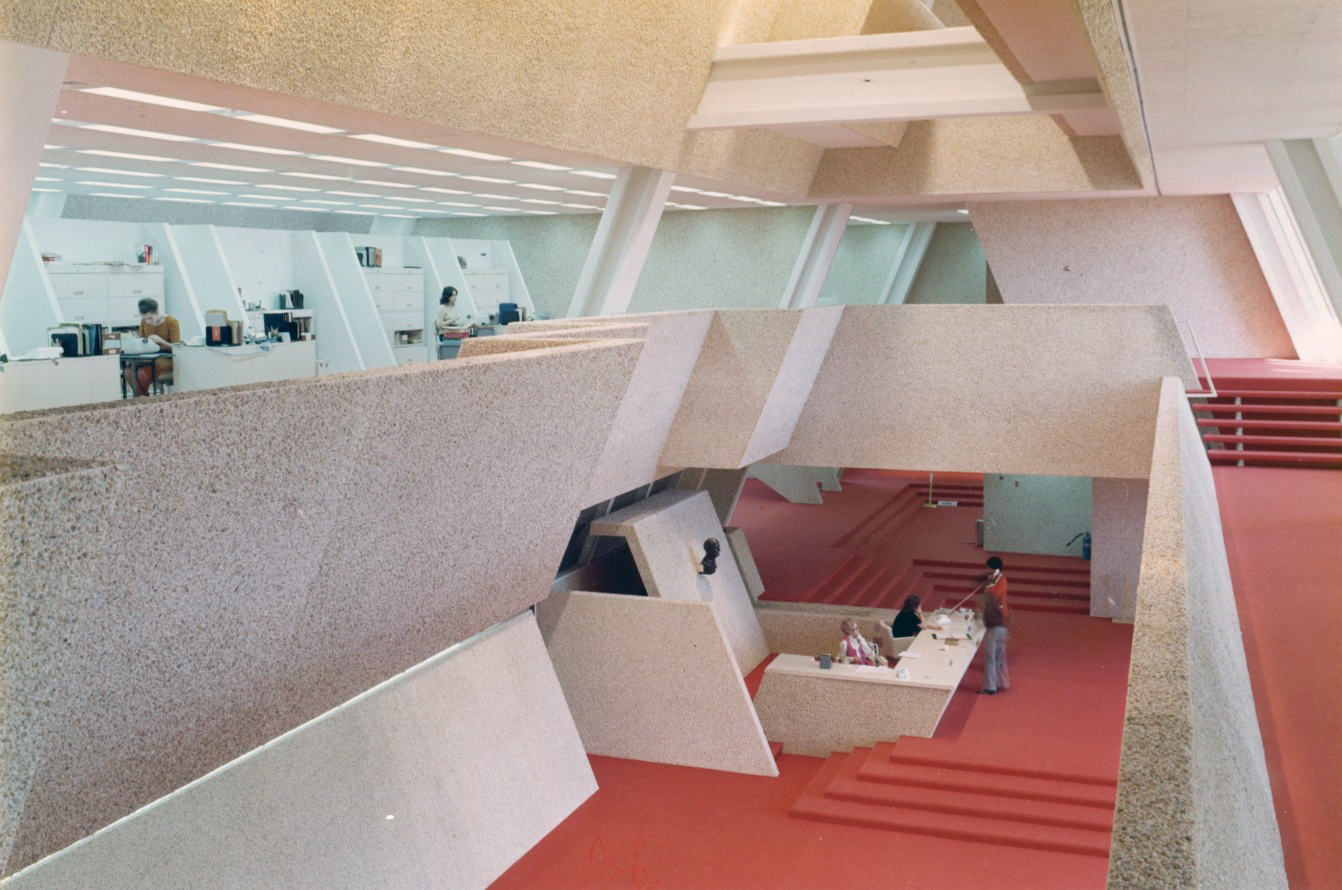
I never did get to see the building up close, much less its interior, and now that its wholesale destruction is imminent (parts of the campus were razed in 2014), I feel a profound sense of regret and even stronger indignation. Over and over, I think public opinion has come so far in terms of appreciation for “late” modernism. This shouldn’t be happening.
Back in the early 2010s, the Brutalist Renaissance had not yet kicked off. If you wanted to read about Brutalism, you had to turn to out-of-print monographs by Reyner Banham or thumb through out-of-print anthologies by Charles Jencks (the latter at least held out the promise of color photography). The current phenomenon of endless decorative pillows, glossy coffee table books, expensive prints, and internet memes devoted to Brutalism was a long way off, and the style was treated with a kind of morbid fascination rather than aesthetic zeal. Not that I count myself as immune. I scan my bookshelf and spot copies of This Brutal World and Concrete Concept, big Taschen volumes exalting the use of concrete as a building material, and laudatory tomes about Rudolph and his contemporaries. I scroll through Twitter and see memes about Brutalism being good and a Tumblr feed of glossy black-and-white pictures of Czech Paneláks, Yugoslav monuments (the subject of a 2018 banner show at the Museum of Modern Art), and British council housing. I read over the copy of what I’ve written about the architectural movement on my own blog, revisit speeches I’ve given at symposia devoted to Rudolph in New York City and Buffalo, dig up a creased Library of Congress program from its 2019 celebration of Rudolph’s centennial.
I do these things and think that I am a fool for believing that the tide of public opinion has changed enough to have prevented a major work of architecture from being carelessly demolished. I am an even bigger fool for believing that public opinion is what stops the destruction of works of art—that the core problem is awareness rather than money. Burroughs Wellcome sits on a very nice parcel of land in Durham’s Research Triangle Park, the Silicon Valley of the south. Its owners are an immeasurably wealthy pharmaceutical company, whose power puts them above the law, but in this case, they don’t even need to wield that power because what they are doing is perfectly legal. It doesn’t matter if Burroughs Wellcome is priceless, unique, a work of spatial, formal brilliance. To its owners it is a burden, a resource sink, a negative sign on a spreadsheet, a broader metaphor for the chief role architecture plays in capitalist society: It is an asset of business, an object whose use-value will always be subordinated to its exchange value, a temporary blemish on the shrinking commodity that is land, and nothing more.
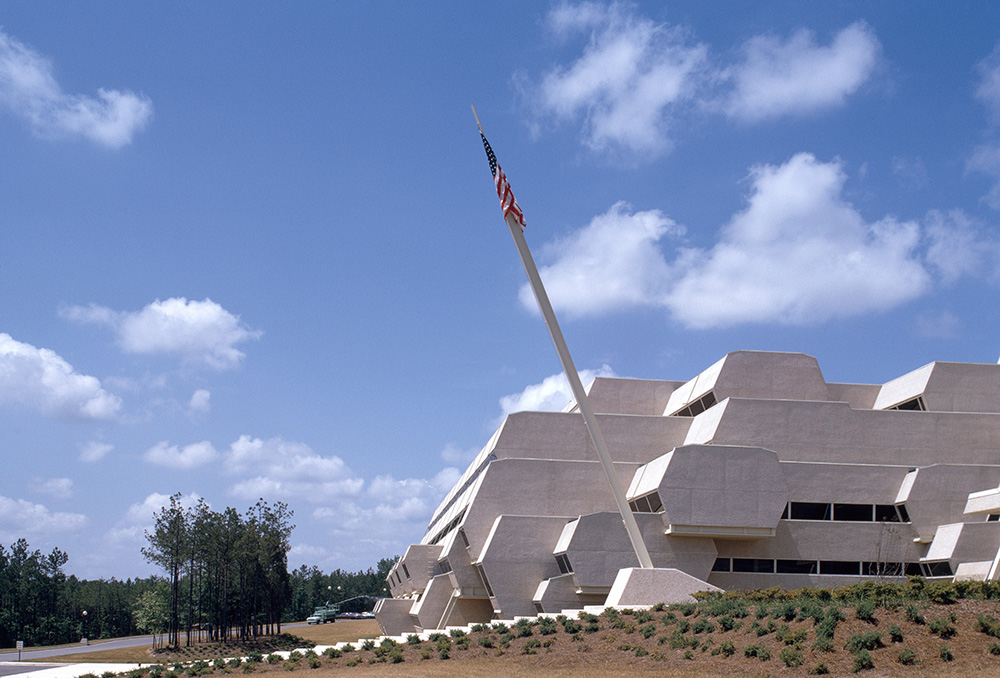
Most works within the Brutalist canon (including Rudolph’s government centers in Orange County and Boston) are despised because of their association with the state. Burroughs Wellcome was the home of a major international company, a titan of capitalism, and that did not save it; in fact, it made it more precarious.
We think we have come so far with our niche coffee table books and expensive framed prints and high-follow-count Instagram pages, that we have finally, through institutions big and small, centralized and individual, de-stigmatized an architectural style that has been contested from birth, and therefore there will be no more needless destruction, but when the news came out about Burroughs Wellcome, a measly Change.org petition, and the anguished protest from the same institutions involved in the fight for the Goshen Building years ago, were all we got. It turns out that image sharing is easy and activism is hard and, as seen with other recent major preservation battles (such as the losing battle to save the lobby of Philip Johnson’s AT&T Building) comes with no guarantee of success.
I write this as a means of processing the impending loss of a building I care deeply about as a historian and as an individual, but also because I believe that the preservation community is facing a hard truth: Their battle is not against one bulldozer-happy company or developer but against an economic system that reduces architecture to an asset that sits upon an even more valuable asset—land. The court of public opinion has no say over the rule of the wallet, and even the success of a decade-long campaign to recuperate Brutalism from the trash heap of history cannot alone save Burroughs Wellcome from the wrecking ball. Time repeats itself—I once sat in a chair in my room on a laptop typing up letters and school assignments devoted to saving the Goshen Building; ten years later, I sit in my office and type this essay about mourning another building by the same architect. Both times, despite it all, grief is mixed with hope.
Kate Wagner is an architecture critic and the creator of the blog McMansion Hell. Her column America By Design can be found in the New Republic.







